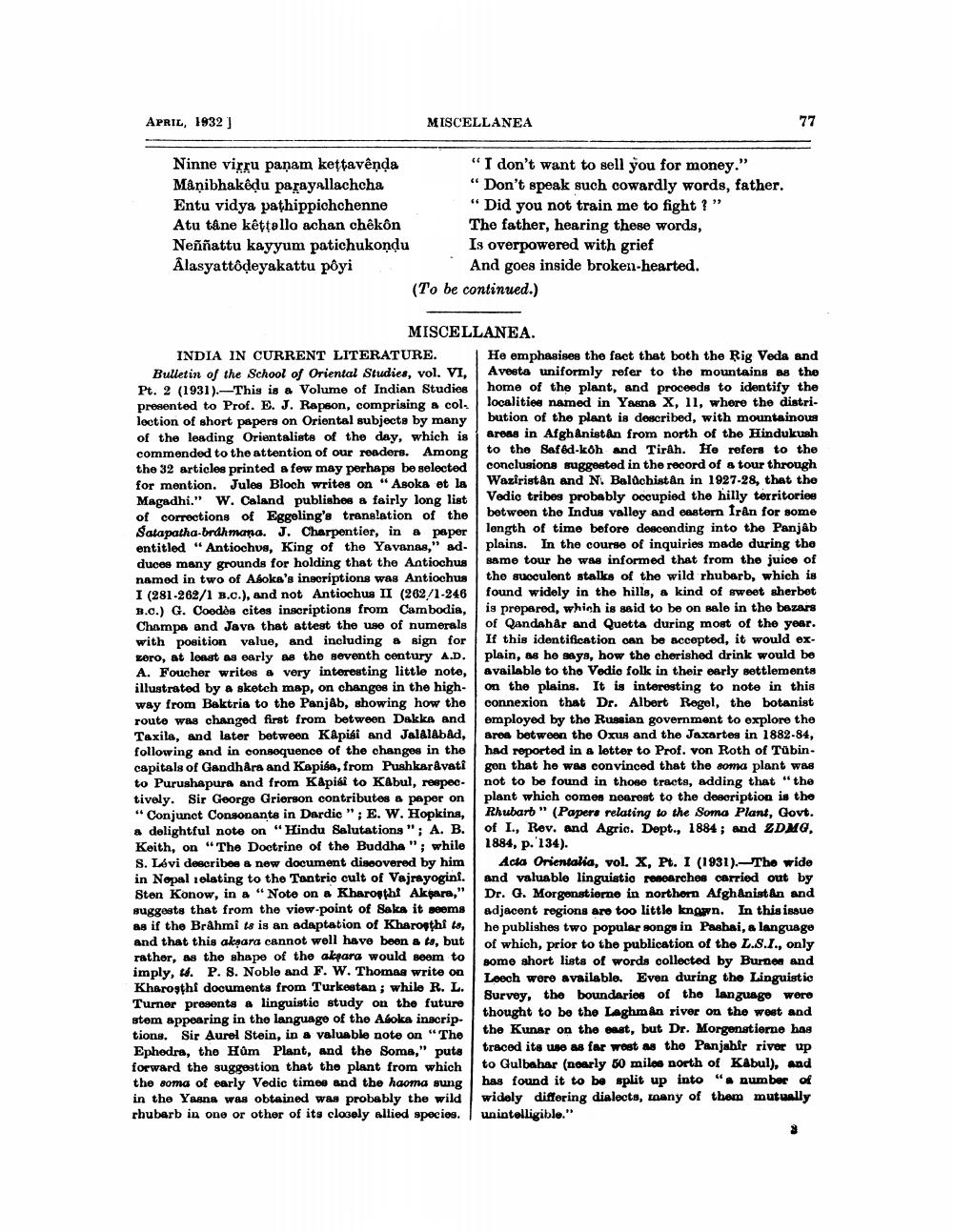________________
APRIL, 1932 ]
MISCELLANEA
Ninne virru paņam kettavênda
"I don't want to sell you for money." Manibhakôdu parayallachcha
"Don't speak such cowardly words, father. Entu vidya pathippichchenne
"Did you not train me to fight ?” Atu tâne kettallo achan chêkôn
The father, hearing these words, Neññattu kayyum patichukondu Is overpowered with grief Alasyattôdeyakattu pôyi
And goes inside broken-hearted. (To be continued.)
MISCELLANEA. INDIA IN CURRENT LITERATURE. He emphasises the fact that both the Rig Veda and Bulletin of the School of Oriental Studies, vol. VI, Avesta uniformly refer to the mountains as the Pt. 2 (1931). This is a Volume of Indian Studies home of the plant, and proceeds to identify the presented to Prof. E. J. Rapson, comprising a col.
localities named in Yasna X, 11, where the distrilection of short papers on Oriental subjects by many
bution of the plant is described, with mountainous of the leading Orientaliste of the day, which is areas in Afghanistan from north of the Hindukush commended to the attention of our readers. Among to the Safed-koh and Tirah. He refers to the the 32 articles printed a few may perhaps be selected
conclusions suggested in the record of a tour through for mention. Jules Bloch writes on "Asoka et la Waziristan and N. Baluchistan in 1927-28, that the Magadhi." W. Caland publishes a fairly long list Vedic tribes probably occupied the hilly territories of corrections of Eggeling's translation of the between the Indus valley and eastern Irên for some Satapatha-brdhmana. J. Charpentier, in a paper length of time before descending into the Panjab entitled "Antiochve, King of the YAvenas," ad. plains. In the course of inquiries made during the duces many grounds for holding that the Antiochus same tour he was informed that from the juice of named in two of Aboka's inscriptions was Antiochus the succulent stalks of the wild rhubarb, which is I (281-262/1 B.C.), and not Antiochus II (202/1-246 found widely in the hills, a kind of sweet sherbet B.O.) G. Coodds cites inscriptions from Cambodia, is prepared, which is said to be on sale in the bazars Champa and Java that attest the use of numerals of Qandahår and Quetta during most of the year. with position value, and including sign for If this identification can be accepted, it would exzero, at least as early as the seventh century A.D. | plain, as he says, how the cherished drink would be A. Foucher writes & very interesting little note, available to tho Vedio folk in their early settlements illustrated by a sketch map, on changes in the high- on the plains. It is interesting to note in this way from Baktria to the Panjab, showing how the connexion that Dr. Albert Rogel, the botanist routo was changed first from between Dakka and employed by the Russian government to explore the Taxila, and later between Kapisi and JalalabAd, area between the Oxus and the Jaxartes in 1882-84, following and in consequence of the changes in the had reported in a letter to Prof. von Roth of Tubincapitals of GandhAra and Kapisa, from Pushkaravati gon that he was convinced that the soma plant was to Purushapura and from Kapisi to Kabul, respec. not to be found in those tracts, adding that "the tively. Sir George Grierson contributes & paper on plant which comes nearest to the description is the "Conjunct Consonants in Dardic"; E. W. Hopkins, Rhubarb " (Papers relating to the Soma Plant, Govt. & delightful note on "Hindu Salutations"; A. B. of I., Rev. and Agric. Dept., 1884 ; and ZDMG, Keith, on "The Doctrine of the Buddha"; while 1884, p. 134). S. Lévi describes a now document discovered by him Acta Orientalia, vol. X, Pt. I (1931).-The wide in Nepal relating to the Tantric cult of Vajrayogini. and valuable linguistic researches carried out by Sten Konow, in a "Note on a Kharopthi Akgara," Dr. G. Morgonstiorno in northern Afghánistan and suggests that from the view point of Sake it seems adjacent regions are too little known. In this issue as if the Brahmi is is an adaptation of Kharopthi ts, he publishes two popular songs in Pasbai, a language and that this aksara cannot well have been a ts, but of which, prior to the publication of the L.S.I., only rathor, as the shape of the aksara would seem to
some short lists of words collected by Burnes and imply, . P.S. Noble and F. W. Thomas write on
Leech were available. Even during the Linguistic Kharosthf documents from Turkestan; while R. L. Turner presents a linguistic study on the future
Burvey, the boundaries of the language were
thought to be the Laghmån river on the west and stom appearing in the language of the Aboka inscriptions, Sir Aurel Stein, in a valuable note on "The
the Kunar on the east, but Dr. Morgenstierne bag Ephedra, the Hum Plant, and the Soma," puts
traced its use as far west as the Panjabir river up forward the suggestion that the plant from which to Gulbahar (nearly 50 miles north of Kabul), and the soma of early Vedic times and the haoma sung has found it to be split up into " number of in the Yasna was obtained was probably the wild widely difforing dialects, thany of them mutually rhubarb in one or other of its closely allied species. unintelligible."




